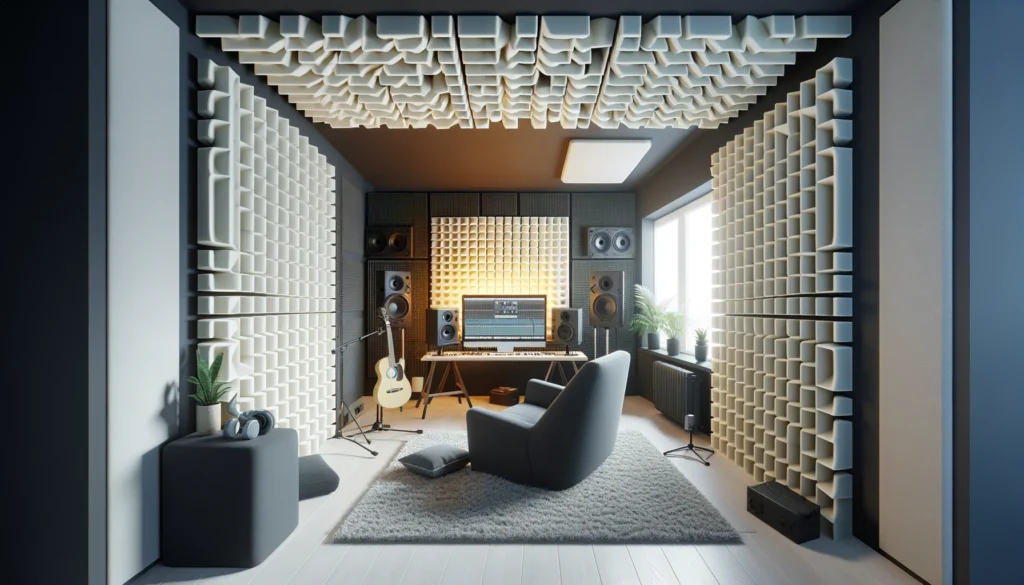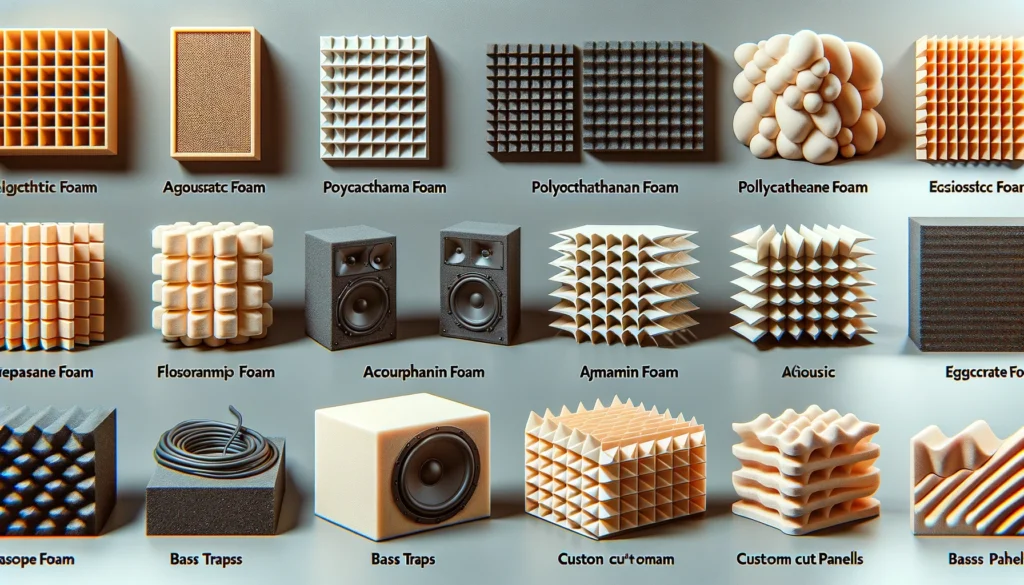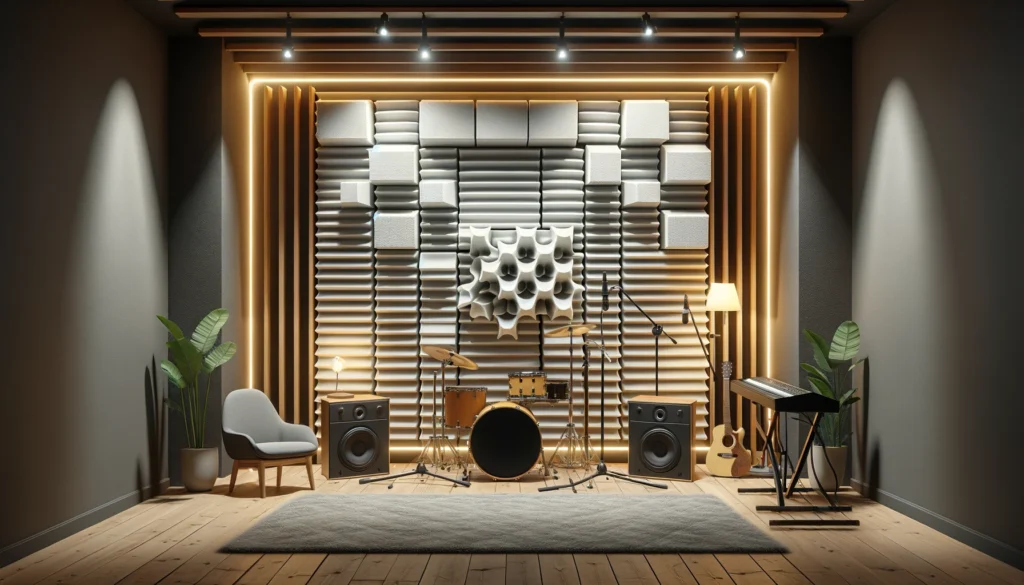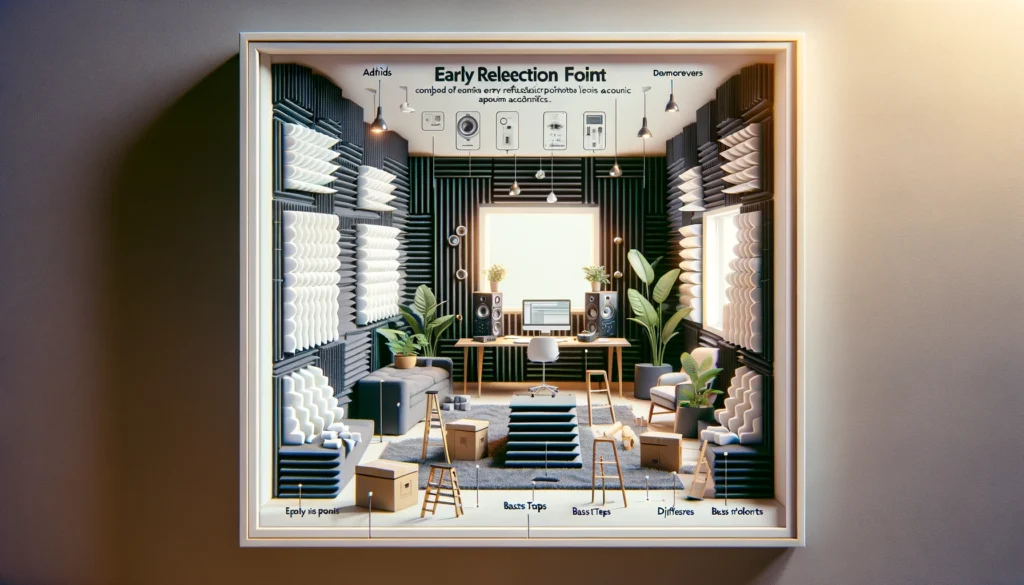Do you ever wonder what that funky, egg carton-looking foam is used for in music studios?
This specially designed material with a unique geometric shape is known as acoustic eggcrate foam, an inexpensive and efficient way to treat audio environments coping with poor sound quality issues.
Let’s dive in to understand exactly what acoustic eggcrate foam is and why it has become an essential component for optimizing acoustic spaces across many different applications.
What is Acoustic Eggcrate Foam?

Acoustic eggcrate foam is a type of sound absorbing material that is used to treat audio spaces and environments to improve their acoustic properties.
It gets its name from its distinctive geometric, egg-crate style pattern that helps to trap sound waves rather than reflecting them.
The foam is designed to absorb unwanted reverberation and echo that can negatively impact sound quality.
By installing acoustic eggcrate foam panels on key surfaces like walls and ceilings, the resonance within a room can be reduced dramatically.
This results in much clearer and higher fidelity sound.
The eggcrate-like shape works by essentially breaking up sound waves and diffusing them.
This interrupts unwanted reverberation that can muddy and distort audio.
The indented peaks and valleys on the face of the foam scatter sound in different directions rather than allowing it tocontinually reflect off flat hard surfaces.
This scattering effect allows the foam to effectively absorb audio across a wide range of frequencies.
Benefits of Using Acoustic Eggcrate Foam

Utilizing acoustic eggcrate foam to treat listening environments and audio spaces comes with many important benefits:
Reduces Reverb and Echo
The key benefit to acoustic eggcrate foam is its ability to reduce excessive reverb and echo within a room.
Unwanted reflections that bounce off hard surfaces can cause audio to be muddy and indistinct.
By installing foam panels, these reflections are broken up and absorbed.
This minimizes the problematic resonant buildup and allows source audio to be much clearer.
Improves Sound Quality
By reducing unwanted reverb and echo, acoustic eggcrate foam directly results in improved sound quality within a space.
Music, vocals, speeches and other audio come across more cleanly without being obscured by excessive reflections.
Critical listening spaces greatly benefit from the enhanced clarity and accuracy that properly installed foam delivers.
Helps Control Background Noise
The sound dampening properties provided by eggcrate foam can also help reduce background noise within a space.
Audio from adjacent rooms or external noise like traffic can negatively impact environments where critical listening occurs.
The noise reducing ability of foam absorbs these unwanted sounds rather than reflecting them, leading to better signal to noise ratio.
Cost-Effective Acoustic Treatment
Compared to many other acoustic treatment products, acoustic eggcrate foam is very affordably priced.
Foam panels can treat spaces at a fraction of the investment needed for materials like fiberglass or rigid fiber boards.
This makes eggcrate foam a very cost-effective solution for studios and listening rooms working on a budget.
Lightweight and Easy to Install
In addition to being an affordable acoustic treatment option, eggcrate foam is also extremely lightweight and easy to install.
Panels can readily be attached to walls and ceilings with adhesive.
No special tools or hardware are required.
This simplicity makes it straightforward for even novices to effectively treat their spaces.
Aesthetically Pleasing Pattern and Texture
Unlike basic flat foam panels, the geometric pattern of acoustic eggcrate foam makes for an interesting visual aesthetic.
The indented grid appearance along with pyramids can add appealing dimension and texture to otherwise plain walls and surfaces.
This helps treated spaces stay visually engaging rather than looking bland or uniform.
Types of Acoustic Eggcrate Foam

There are a few varieties of acoustic eggcrate foam, each with their own attributes:
Polyurethane Foam
The most common and cost-effective type is polyurethane foam.
This style utilizes polyurethane for the eggcrate shaped grid pattern.
Polyurethane foam can effectively absorb sound across a wide frequency range while being very affordably priced.
It also holds up well over time without flattening out or losing acoustic integrity.
Acoustic Pyramid Foam
For increased sound dampening, pyramid style foam combines pyramid and eggcrate geometry.
The pyramids help break up sound waves while the recessed grids trap and absorb audio.
This hybrid foam helps minimize even more excess reverb and echo making it well suited to spaces in need of heavy acoustic treatment.
Bass Traps
Specialized eggcrate foam bass traps target low frequency absorption unlike standard foam which focuses more on mid to high frequencies.
The contoured shape boosted by increased foam thickness helps control resonances from sources like speakers and subwoofers.
This leads to greatly reduced boominess.
Custom Cut Panels
For precise coverage, some companies offer custom sized and cut acoustic eggcrate foam panels.
Tailoring panels to exactly fit specific spaces helps optimize placement and coverage area.
Irregular shaped rooms can benefit from this customized approach.
Best Uses for Acoustic Eggcrate Foam

There are many situations where utilizing acoustic eggcrate foam can dramatically improve audio quality:
Home Studios
Personal home studios for recording vocals, instruments, podcasts and more benefit tremendously from foam treatment.
Small irregularly shaped rooms with challenging acoustics get far less reflective allowing for better quality recordings.
Foam is an affordable option for home studios without big budgets.
Auditoriums and Theaters
Large venues dealing with substantial reverberation issues quickly improve when acoustic eggcrate foam gets installed.
The material is very effective at reducing unwanted reflections caused by excessive hard surfaces found in most auditoriums and theaters.
This leads to great hearing conditions for audiences.
Schools
Band rooms, choir rooms and other education spaces have the challenge of managing many audio sources in one often irregularly sized room.
Eggcrate foam addresses these issues well by absorbing sound from all directions.
Voice and instruments gain clarity while volume can be reduced.
Offices and Conference Rooms
Shared office spaces, conference rooms and density open concept offices contribute substantial ambient noise that hampers concentration and communication.
Applying acoustic eggcrate foam to ceilings, walls and room dividers cuts down on excess reflections amplifying these unwanted sounds.
Recording Studios and Music Venues
Professional recording studios and music performance venues greatly utilize eggcrate foam for improving audio quality.
Control rooms, tracking rooms, isolation booths and hallways all benefit from foam reducing flutter echo and other excessive reflections that can ruin recordings and live performances.
Installation Tips and Tricks

Properly installing acoustic eggcrate foam comes with some key tips and tricks:
Precise Measurement
Taking exact measurements allows panels to be custom cut minimizing wasted materials.
Measure twice for accuracy taking into account any irregularities on installation surfaces.
Consider room layout and furniture placement as well when measuring.
Using Adhesives
Quality foam adhesives securely fasten panels to surfaces while still allowing clean removal later if needed.
Alternatives like glue or tape may not bond as strongly over time compared to purpose-made acoustic foam adhesives.
Follow instructions closely when applying adhesive.
Focus on Early Reflection Points
Identify key early reflection points within a space by using a mirror or your own observations when sound is produced.
These first surface bounce spots greatly benefit from foam absorption so concentrate application in these areas first.
Combine with Other Acoustic Treatments
While very effective, eggcrate foam alone may not address all sound problems in a space.
Combine foam with other acoustic treatments like bass traps and diffusers for comprehensive sound control tailored to the specific issues present.
Conclusion
In conclusion, acoustic eggcrate foam provides an affordable and effective solution to improving audio spaces coping with excess reverb, echo, and background noise.
The foam’s specialized geometric structure optimizes sound absorption across a wide range, making it hugely beneficial for many different environments.
Music venues, theaters, studios, classrooms and offices all utilize acoustic eggcrate foam to great success.
With informed installation taking advantage of adhesive mounting and strategic placement, the simple foam material can drastically transform challenging acoustic environments.
No space needing better sound control should overlook acoustic eggcrate foam treatments.
